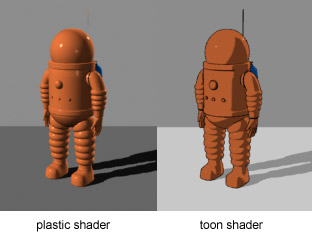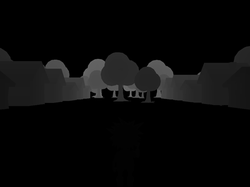Cel shading
This article needs additional citations for verification. (March 2009) |

Cel shading, cell shading, or toon shading is a type of non-photorealistic rendering designed to make 3-D computer graphics appear to be flat by using less shading color instead of a shade gradient or tints and shades. A cel shader is often used to mimic the style of a comic book or cartoon and/or give the render a characteristic paper-like texture.[1] There are similar techniques that can make an image look like a sketch, an oil painting or an ink painting. The name comes from cels (short for celluloid), clear sheets of acetate which were painted on for use in traditional 2D animation.[2]
Basic process[]

The cel-shading process starts with a typical 3D model. Where cel-shading differs from conventional rendering is in its non-photorealistic illumination model. Conventional smooth lighting values are calculated for each pixel and then quantized to a small number of discrete shades to create the characteristic "flat look", where the shadows and highlights appear as blocks of color rather than being smoothly mixed in a gradient.
Outlines[]
Wireframe method[]
Black ink outlines and contour lines can be created using a variety of methods. One popular method is to first render a black outline, slightly larger than the object itself. Back-face culling is inverted and the back-facing triangles are drawn in black. To dilate the silhouette, these back-faces may be drawn in wireframe multiple times with slight changes in translation. Alternatively, back-faces may be rendered solid-filled, with their vertices translated along their vertex normals in a vertex shader. After drawing the outline, back-face culling is set back to normal to draw the shading and optional textures of the object. Finally, the image is composited via Z-buffering, as the back-faces always lie deeper in the scene than the front-faces. The result is that the object is drawn with a black outline and interior contour lines. The term "cel-shading" is popularly used to refer to the application of this "ink" outlining process in animation and games, although originally the term referred to the flat shading technique regardless of whether the outline was applied.[3]
The Utah teapot rendered using cel shading:

- The back faces are drawn with thick lines
- The object faces are drawn using a single color
- Shading is applied
Steps 2 and 3 can be combined using multitexturing (part of texture mapping).
Edge-detection method[]





In video games[]
The Sega Dreamcast title Jet Set Radio, which was revealed at the 1999 Tokyo Game Show, drew media attention for its cel-shaded style.[4][5] It used cel-shading for its characters and its vibrant visual style has had a lasting influence on the use of cel-shading in video games. The PlayStation title Fear Effect also had character models that are cel-shaded, and was released in February 2000, several months before Jet Set Radio officially released in mid-2000. Since the early 2000s, many notable video games have made use of this style, such as The Legend of Zelda: The Wind Waker (2003) and Ōkami (2006).
Cel shading, in contrast to other visual styles such as photorealism, is often used to lend a more artistic or fantastical element to a video game's environment. In developing Ōkami, director Hideki Kamiya described his vision for the game's graphics: "I wanted to create a game with the natural beauty of the Japanese countryside... to make a world that was glistening and beautiful[6]." Producer Atsushi Inaba recalls in a 2004 interview that Clover Studios had "abandoned the realistic style[6]" for Ōkami as they became inspired by traditional Japanese art.
Game studios might choose a style such as cel shading in their development for reasons beyond artistic vision. Cel shaded graphics are usually simple in visual information, which can be useful in some applications. In the case of The Legend of Zelda: The Wind Waker, developer Satoru Takizawa states that using this style made it easier to "represent the mechanisms and objects for puzzles [in The Wind Waker] in a more easy-to-understand way[7]". Takizawa also argues that photorealistic graphics, in contrast, would have "had the adverse effect of making information difficult to represent game-wise[7]".
Lists of cel-shaded media[]
This article needs additional citations for verification. (July 2021) |
Commercials[]
- 1999 Télétoon Télétoon Advance
- 2002 Piwi Les Vacances de Piwi
- 2008 Scion xD Little Deviants
- 2009 Dodge Journey
- Boogie
- BP Connect 2007 ads
- AREVA
- Nick Jr. ID's by Steve Speer
- Commit mint lozenges
- HSBC HSBCdirect.com
- Hewlett Packard xw8400 Workstation Titans of iron
- Mr. Clean
- Pampers Kandoo Flushable Toilet Wipes, Foaming Handsoap, Foaming Shampoo & Body Wash
- Luvs Bear Hug Stretch, Heavy Doody Blowout Protection
- Post Cereals Fruity Pebbles cereal (Bowling for Fruity Pebbles ad)
- Lego Exo-Force
- L'Oréal Couleur Expert
- Lunchables Pizza (Atlantis Paradise Island promotion ad)
- McCain's Zwak Punch
- Neopets virtual prize code (Canadian Betty Crocker fruit-flavored snacks promotional ad)
- Oscar Mayer Lunchables Chicken Dunks (Airhead Mysteries ad)
- 2020 Rybelsus
- Sola/Nero/Vena/Olera/Zonte sparkling wine
- Toyo Tires Versado LX all-season touring tires ( promotional ad)
Film[]
- The Adventures of Rocky and Bullwinkle (2000)
- Hot Wheels: World Race, a 2003 computer-animated direct-to-video film.
- Appleseed, a 2004 Japanese animated film.
- A Scanner Darkly, a 2006 film based on Philip K. Dick novel.
- Mutafukaz: Operation Blackhead, a 2017 crime short film that became the basis for the comic book for the same name produced by Run.
- Tom & Jerry, a 2021 live-action/computer-animated slapstick comedy film based on the characters of the same name created by William Hanna and Joseph Barbera.
- The Pink Panther directed by Jeff Fowler
Television[]
- Molly, Star-Racer - a 2001 French television pilot produced by Sparx Animation Studios
- Dragon Booster - a 2004 Canadian television series produced by Nerd Corps Entertainment
- Handy Manny - a 2006 American-Canadian children's television series produced by Nelvana
- Z-Squad - a 2006 South Korean-Canadian magical girl television series produced by Enemes, SBS, CJ Entertainment and Nelvana
- Storm Hawks - a 2007 Canadian television series produced by Nerd Corps Entertainment
- League of Super Evil - a 2009 Canadian television series produced by Nerd Corps Entertainment
- Bunny Maloney - a 2009 French television series produced by MoonScoop Group, France 2 and Telegael
- Iron Man: Armored Adventures - a 2009 French-American television series produced by Marvel Animation
- Hot Wheels Battle Force 5 - a 2009 Canadian television series produced by Nerd Corps Entertainment and Nelvana
- Rated A for Awesome - a 2011 Canadian television series produced by Nerd Corps Entertainment
- Regal Academy - a 2016 Italian television series produced by Rainbow S.p.A.
- What If...? - a 2021 Marvel Studios alternate history television series set in the Marvel Cinematic Universe[8]
Video games[]
See also[]
References[]
- ^ "Stylized Rendering Post Processing". docs.unrealengine.com. Retrieved 2019-09-13.
- ^ Hachigian, Jennifer. "Celshader.com FAQ". Retrieved August 2, 2005.
- ^ Luque, Raul (December 2012). The Cel Shading Technique (PDF). Retrieved December 2, 2014.
- ^ "IGNDC Interviews The Creators of Jet Grind Radio". IGN. 26 May 2000. Retrieved 12 August 2021.
- ^ "TGS: Sega Shows Jet Grind Radio". GameSpot. September 19, 1999. Archived from the original on July 18, 2014. Retrieved August 12, 2009.
- ^ a b "shmuplations.com". shmuplations.com. Retrieved 2021-06-01.
- ^ a b "Iwata Asks". iwataasks.nintendo.com. Retrieved 2021-06-01.
- ^ Tadeo, Jericho (August 10, 2021). "Why Some People Are Bothered By Marvel's What If Animation Style". Screen Rant. Archived from the original on August 11, 2021. Retrieved August 29, 2021.
External links[]
- IGN: Jet Set Radio review. Retrieved August 4, 2005.
- GameDev.net – Cel-Shading. Retrieved August 5, 2005.
(Wayback Machine copy)
- sunandblackcat.com – Cel-Shading. Retrieved August 7, 2014.
- tv tropes about cel-shading. Retrieved December 2, 2014
- Animation techniques
- Cel-shaded animation
- Computer animation
- Shading
- Video game graphics